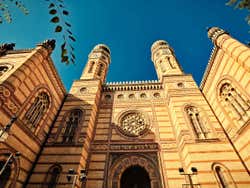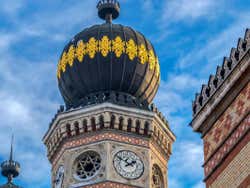
Great Synagogue in Budapest
The Great Synagogue of Budapest is the second largest synagogue in the world, after the Great Synagogue in Jerusalem.
The synagogue was built between 1854 and 1859. It was designed by the Austrian architect Ludwig Forster. It's predominantly Arab in style, although it also has Byzantine, Gothic, and Romanesque styles. It's 53 m high and 26 m wide and can seat up to 2,964 people, of which 1,492 are men and 1,472 are women.
The Synagogue is also called Tabakgasse Synagogue, the Great Synagogue, or Dohány Street Synagogue. In Hebrew, dohány means tobacco.
The Jewish Ghetto
During World War II, the Nazis created a Jewish Ghetto around the Great Synagogue, which was later transformed into a concentration camp. From this camp, many Hungarian Jews were sent to the extermination camps.
Over 2,000 Jews died of hunger and cold in the ghetto during World War II. The bodies were buried in the cemetery just in front of the Great Synagogue.
Visiting the Great Synagogue
Outside the synagogue is the Jewish cemetery (not as striking as the Jewish cemetery in Prague. A sculpture in the form of a weeping willow called the Tree of Life was created in 1991 in memory of all Jews who died during the War. Each leaf has the name of a person who passed away during the Jewish persecution inscribed on it.
To visit, you will need to make a reservation, which you can do through this link. There are two options available: a simple tour of the Great Synagogue or a combined tour that also includes the Jewish quarter:


Schedule
Winter opening hours:
Sunday - Jueves: 10:00 am - 4:00 pm.
Viernes: 10:00 am - 2:00 pm.
Spring opening times:
Sunday-Jueves: 10:00 am - 6:00 pm.
Viernes: 10:00 am - 4:00 pm.
Summer opening hours:
Domingo-Jueves: 10:00 am - 8:00 pm.
Closer: 10:00 am - 4:00 pm.
Autumn opening hours:
Sunday-Jueves: 10:00 am - 6:00 pm.
Viernes: 10:00 am - 4:00 pm.
Price
Adults: 1,300 Ft (US$ 3.97)
Students: 10,500 Ft (US$ 32.12)
Children aged 6 to 12 years: 5,000 Ft (US$ 15.29)
Children under 6 years old: free entry.
Families (2 adults and 2 children): 30,000 Ft (US$ 91.79)
Great Synagogue Guided Tour € 59 (US$ 69.38)
Nearby places
Hungarian National Museum (547 m) Váci Utca (608 m) Inner City Parish Church (717 m) St. Stephen’s Basilica (717 m) State Opera House (753 m)

